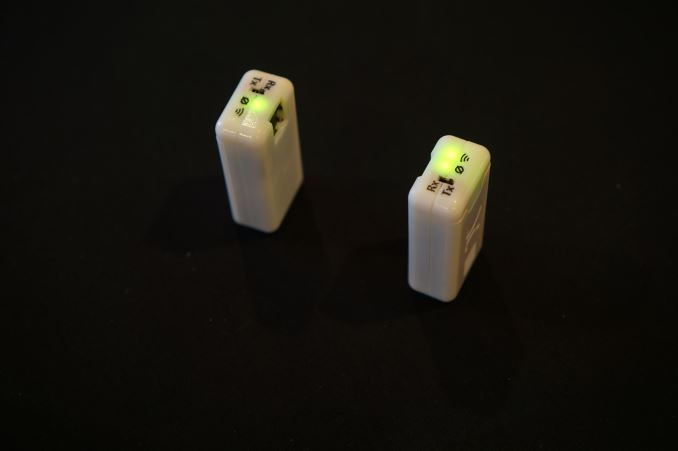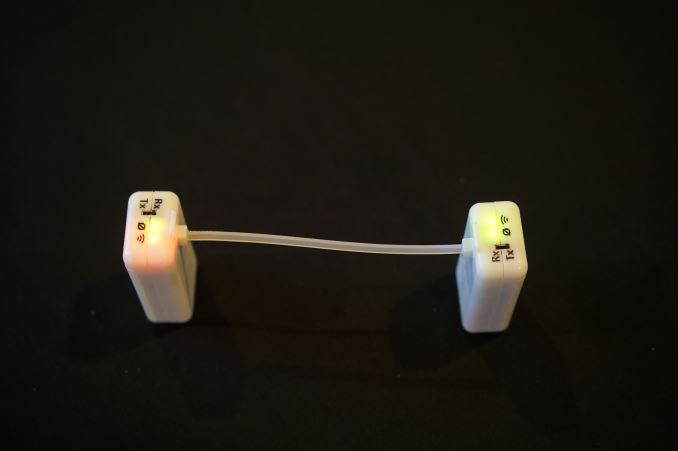Revisiting Keyssa: Commercial Availability, Products in Q1 2016
by Joshua Ho on January 7, 2016 7:00 AM EST- Posted in
- Mobile
- Trade Shows
- Keyssa
- CES 2016

While we talked about Keyssa at CES last year, details were rather sparse as the technology was still in the early stages of getting off the ground. However, this year Keyssa’s connector technology is now commercially available. Based upon discussions with those at Keyssa, products with this new technology could ship as early as Q1 2016.
For those that haven’t seen Keyssa in action before, it’s hard to really understand the potential of this technology. At a high level, it’s basically like NFC in the sense that this technology is very short range wireless with a range of roughly an inch or a few centimeters before the 60 GHz signal disappears completely. However, within that range you get 6 Gbps of bandwidth and relatively low power compared to something like 802.11ad/WiGig. Unlike 802.11ad WiFi, the connector and chip needed to enable this technology is almost absurdly tiny, as the chip is no more than a few millimeters squared. This is purely a physical layer technology, which means that at the operating system level a Keyssa connector can appear to be USB, DisplayPort, HDMI, SATA, PCIe, and pretty much any point to point digital connection protocol you can name today.
As a result, Keyssa has the potential to completely do away with physical data ports in devices. Probably the most obvious example of this would be 2-in-1 hybrid devices like the Surface Book, which in theory could completely do away with all of the wired connections that introduce additional engineering challenges when designing a device like the Surface Book.
Keyssa has also discussed the potential to replace flex cables internally in smartphones and other devices, which could reduce board area and/or z-height along with simplifying design and reducing cost as flex cables would no longer need to be laid out by hand.
This connector can also use simple plastic with certain shapes like tubes to introduce directionality and make wire-like connections over distance without the need for actual wires or proper connections.
Overall, Keyssa shows great potential and judging by the discussions I’ve had there’s a significant amount of interest from OEMs and ODMs for this technology, with hints that devices with this technology are already in development. It’s hard to say what the full potential of this technology is, but it’s definitely going to be interesting to see how this develops.













28 Comments
View All Comments
name99 - Thursday, January 7, 2016 - link
Why an audio jack? Believe you will see a MILLION reasons why this is the most important jack in the world, and why taking it away threatens our freedoms, when Apple introduces the iPhone 7 without it...Samus - Thursday, January 7, 2016 - link
Seriously, having an audio jack is like having a parallel port. The best use for an audio jack in this decade was the PRESSY button, which was a hardware failure because it was made like crap, but gave an otherwise useful job to a useless port.Bluetooth with aptX renders a 3.5mm jack completely stupid on a phone. The crevice is a cesspool of dirt, accounts for the most likely location of water damage (which is why they put the moisture sensor in there) and it makes phones larger and thicker than they could otherwise be...not that I care about razor thin phones but it'd be nice if they were thinner at the ends.
ddriver - Friday, January 8, 2016 - link
You can't wirelessly transmit signal, powerful enough to drive headphones silly.Liquid5n0w - Thursday, January 7, 2016 - link
The obvious application is a phone with 0 connectors and included bluetooth headset. It would be trivial to make it waterproof, the only complication being being the SIM card slot and the power/volume buttons.olafgarten - Thursday, January 7, 2016 - link
Just have a universal sim card that can be activated on different networks that is sealed inside the phone.jardows2 - Thursday, January 7, 2016 - link
I'm a little concerned with that strong of a wi-fi signal being blasted into my brain. I would hope there would be some good tests of the effects of such a strong signal that close to the body before people start putting a phone up to their ear for hours a day.extide - Thursday, January 7, 2016 - link
Huh, what are you talking about?1- The signal wouldn't be near your brain at all. It would be at the end of the cord on your headphones.
2- The signal only goes a few CM before it drops off, which probably means it's extremely high frequency, (~60+GHz)
3- Something that high of frequency would barely pass through your skin anyways, and definitely not through your skull.
4- It's not WiFi, and it's not a strong signal.
How do people read that areticle and then completely miss all of this..?
mkozakewich - Thursday, January 7, 2016 - link
They've already got virtual SIMs.ddriver - Thursday, January 7, 2016 - link
Wireless USB sounds very insecure. Anyone can come close to your pocket and compromise your device. This tech will need explicit permissions from the users to be safe, much like bluetooth pairing, so even if wireless it won't be completely hassle-free.JoshHo - Thursday, January 7, 2016 - link
The images shown were designed to give some sense of the distance that the signal can propagate before noise hides all signal.You would have to be almost touching the other person's pocket, which would be at least somewhat alarming.